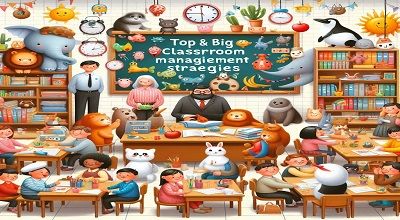Classroom Management Strategies
In this article Top 19 Small & Big Classroom Management Strategies. Effective classroom management is essential for creating a positive and productive learning environment, whether you’re dealing with a small or large class. Here are 19 classroom management strategies that can work in various settings:
1. Establish Clear Rules and Expectations: Develop a set of clear and consistent rules that outline behavior expectations in your classroom. Communicate these rules to your students and enforce them consistently.
2. Build Positive Relationships: Develop strong, positive relationships with your students. When students feel valued and respected, they are more likely to behave well in the classroom.
3. Use Positive Reinforcement: Reward and praise students for good behavior and academic achievements. Positive reinforcement can motivate students to follow rules and excel in their studies.
4. Consistency: Be consistent in your enforcement of rules and consequences. Students need to know what to expect.
5. Classroom Design: Arrange the classroom layout to minimize distractions and encourage engagement. Consider seating arrangements that suit the specific needs of your students.
6. Clear Communication: Use clear and direct communication when giving instructions or addressing behavior issues. Ensure that students understand your expectations.
7. Proximity Management: Move around the classroom to monitor and address student behavior. Being physically present can deter misbehavior.
8. Active Engagement: Plan lessons that actively engage students. When students are engaged, they are less likely to act out.
9. Differentiation: Recognize and accommodate different learning styles and abilities. Provide activities and materials that meet diverse student needs.
10. Time Management:
Develop a schedule that allows for smooth transitions and minimizes downtime. A structured routine can help maintain order.
11. Behavior Contracts: Consider behavior contracts for individual students who may need additional support in managing their behavior. These contracts outline expectations and consequences.
12. Group Dynamics: Promote a positive classroom culture by addressing group dynamics and encouraging teamwork.
13. Conflict Resolution Skills: Teach students conflict resolution and problem-solving skills to help them manage conflicts effectively.
14. Use Technology Wisely: Integrate technology into your lessons in a way that enhances learning and minimizes distractions.
15. Visual Aids: Utilize visual aids like posters or charts to reinforce rules and procedures. Visual reminders can be helpful.
16. Data Tracking: Keep records of student behavior to identify patterns and address persistent issues. Use data to make informed decisions.
17. Student Input: Involve students in the creation of classroom rules and consequences. When they have a say in the process, they are more likely to buy into the expectations.
18. Time-Outs: Use time-outs or cool-down areas when necessary to give students a chance to regain control of their emotions and behavior.
19. Professional Development: Continuously seek professional development opportunities to improve your classroom management skills. Attend workshops, seminars, and conferences to learn new strategies.
Note:
The effectiveness of these strategies can vary based on the age and individual needs of your students. It’s important to adapt and tailor your approach as necessary to create a positive and productive classroom environment.
